ABOUT
Inklings: Etched in Memory
19世紀にヨーロッパで発明された写真技法について
> see also: W H Talbot and The Origins of Photogravure(ウィリアム・ヘンリー・タルボットと写真技術の誕生)
How photogravure emerged from Renaissance optics, chance discoveries of light-sensitive materials, and etching and printmaking technique, and the resulting transformation of our visual experience.
by Peter Miller
Etchings, engravings, photogravures, and other intaglio works are unique in the print world for the depth they impart to their subjects, through ink impressed into the fibers of paper. They somehow call forth memories of distant times and places. In photogravure etchings, the here-and-now of photography mixes familiar contemporary surroundings with deep time and distant memories.
The stuff of memory is whatever stands out from the flow of time, staying current through intense emotion — impressions formed ‘in the heat of the moment’. Desire and longing, dread and repulsion, immersion in some unfathomable immensity, excitement, dream-states are vividly remembered, re-lived, and re-created in art. The viewer’s transposition into the image gives the uncanny sense of having ‘been there’ before. The re-experienced excitement or tranquillity that emanates from the etched image is a response to its texture, form, light-and-shadow, composition, tone, and color.
Souvenirs
Very soon after a souvenir is ‘captured’, it escapes. As a documentary reference only, it quickly loses whatever evocative power it was intended to have at the moment of ‘capture.’ Like the toys in the attic or the paisley ties in the closet, photos that merely document an event or a personage, isolated from the emotion that once animated them, become ghosts of themselves. Even more alarmingly, the very world that they represent is also subject to gradual disappearance. As anyone who has returned to a formerly familiar place after a long absence knows, ‘you can’t go home again’ because everything you knew now exists only in memory. And so the apparently permanent solidity of the physical world is revealed as an illusion, visible only by means of photons reflected into specially adapted organs which apprehend light in all its tones and hues, detect form and motion, recognize patterns, and appreciate beauty. Etchings, and the other graphic arts, work not by copying our visual surroundings, but by interpreting and re-casting them, thereby renewing their (and our) existence. They do this by drawing viewers directly into intense experiences of desire, fear, longing, empathy, or other emotions that bypass rational thought.
Landscape art in the past often made its living by professing fidelity to nature. It persisted in this fiction through a remarkable variety of guises — Heavenly, Arcadian, Pastoral, Topographical, Sublime, in accordance with the desires of the day. These conventions were adopted by designers of parks and gardens, realizing on the ground what had previously existed only as abstractions. Thus Victorian English gardens, inspired by French landscape painting, featured a variety of textures, a path for the eye to travel from foreground to middle distance to horizon, and a touch of classical allegory. Even while this peaceful vision reigned in gardens, landscape art found in the ‘Sublime,’ an exciting mix of beauty and danger, favoring craggy peaks, steep waterfalls, isolated passes; followed by outright celebrations of the violent and uncontrollable forces of nature, in storms, tempests, and extreme environments.
Yet the illusion of documentary fidelity persists. Twentieth-century art banished representation while clinging to the illusion of capture, claiming to depict unseen or conceptual realities. Allegiance to the realist program nowadays owes much to the intellectual and artistic freedoms developed during the European Renaissance.
The Illusion of Realism in European Printmaking
After more than a millennium of exclusive authority in its domains, the Renaissance witnessed the Roman Catholic Church’s surrender of its monopoly on the Truth. Crucial to this revolution was the simple determination of artists and scientists to see things for themselves. The conceptual means for doing so was Renaissance perspective, new optical devices the physical means; together they provided what was considered an objective view of the everyday world. The enormous progress in human freedom that came from this new vision gave quasi-Divine status to Truth, documentary accuracy, and realism for centuries to come. (Not until the 20th century were doctrines of artistic realism explicitly rejected in theory; even then, fantasies, dreams, and other unseen states of being were adopted as sources of inspiration and elements of Truth in artistic practice.)
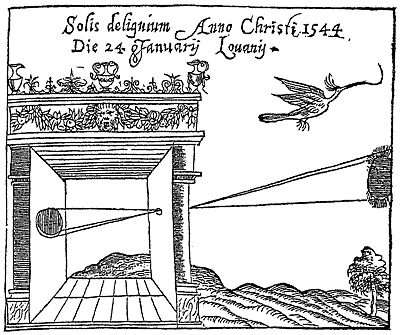 The discovery that light rays enter the human eye like a virtual pyramid was quickly taken up by artists to enhance the realism of their work. In 1525, Durer illustrated the principle that a vertical section of this virtual pyramid could render the three-dimensional world accurately on a two-dimensional surface. The method was further refined in 1553, when the first written description of a ‘camera oscura’ appeared, explaining how light rays could be focused by a pinhole onto the opposite wall of a dark room, casting an accurate (though upside-down) image of the world outside. In 1568, a professor at the University of Padova found that a ground-glass lens gave a clearer, more brilliant image than the pinhole. Thus photo-like pictorial documentation was already built into European art several centuries before the actual invention of photography. The technical means of realizing Renaissance perspective through photography awaited further developments in optics, light-sensitive materials, and etching.
The discovery that light rays enter the human eye like a virtual pyramid was quickly taken up by artists to enhance the realism of their work. In 1525, Durer illustrated the principle that a vertical section of this virtual pyramid could render the three-dimensional world accurately on a two-dimensional surface. The method was further refined in 1553, when the first written description of a ‘camera oscura’ appeared, explaining how light rays could be focused by a pinhole onto the opposite wall of a dark room, casting an accurate (though upside-down) image of the world outside. In 1568, a professor at the University of Padova found that a ground-glass lens gave a clearer, more brilliant image than the pinhole. Thus photo-like pictorial documentation was already built into European art several centuries before the actual invention of photography. The technical means of realizing Renaissance perspective through photography awaited further developments in optics, light-sensitive materials, and etching.
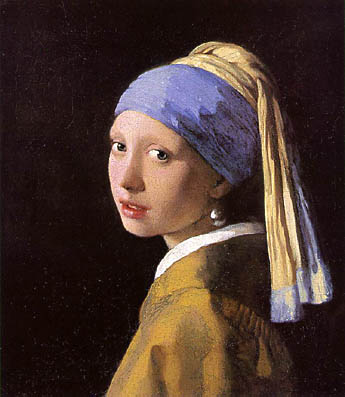 European artists throughout the pre-photographic era took advantage of the new optical devices to enliven the realism of their work. They used a variety of optical devices — lenses, mirrors, pinhole-lit dark rooms (camera obscura), and later, portable image focusers (camera lucida). In the 1600s, portraits, interiors, and landscapes acquired a lifelike perspective and detail such as could have only been seen through a lens. The results were strikingly different from the stiff, posed look of previous art. Vermeer clearly used lighting effects that came from peering through a lens. Look at the way the ‘Girl with a Pearl Earring’ stares at you. That bold glance, that spontaneous moment, is positively photographic. Canaletto, too, is known to have used a camera lucida to compose his etchings and paintings of Venice and London, though he changed things to make his vedute(views) more appealing.
European artists throughout the pre-photographic era took advantage of the new optical devices to enliven the realism of their work. They used a variety of optical devices — lenses, mirrors, pinhole-lit dark rooms (camera obscura), and later, portable image focusers (camera lucida). In the 1600s, portraits, interiors, and landscapes acquired a lifelike perspective and detail such as could have only been seen through a lens. The results were strikingly different from the stiff, posed look of previous art. Vermeer clearly used lighting effects that came from peering through a lens. Look at the way the ‘Girl with a Pearl Earring’ stares at you. That bold glance, that spontaneous moment, is positively photographic. Canaletto, too, is known to have used a camera lucida to compose his etchings and paintings of Venice and London, though he changed things to make his vedute(views) more appealing.
Renaissance artists believed that everything, from the proportions 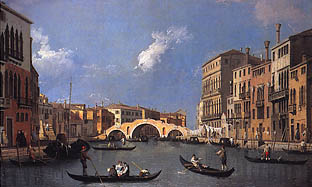 of the human body to the Golden Mean in architecture, and perspective in landscape, could be expressed mathematically, uniting Truth and Beauty in one endeavor. Since then, the visual culture of the West has embraced the view of an all-seeing ‘I’ delineating an objective, geometric view of Nature. Geometric abstraction reappeared in the 20th century as Cubism, the grids of Piet Mondrian, Bauhaus design, color field painting, computer graphics, and fractal art. Ray-tracing, a familiar staple of computer graphics and 3-D design today, is a direct descendant of Renaissance perspective.
of the human body to the Golden Mean in architecture, and perspective in landscape, could be expressed mathematically, uniting Truth and Beauty in one endeavor. Since then, the visual culture of the West has embraced the view of an all-seeing ‘I’ delineating an objective, geometric view of Nature. Geometric abstraction reappeared in the 20th century as Cubism, the grids of Piet Mondrian, Bauhaus design, color field painting, computer graphics, and fractal art. Ray-tracing, a familiar staple of computer graphics and 3-D design today, is a direct descendant of Renaissance perspective.
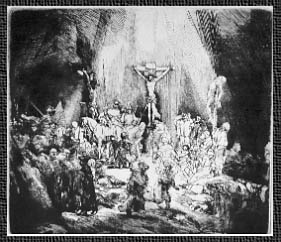 Further pursuit of realism led to new techniques of tonal differentiation and lighting contrasts to show volume and depth, most dramatically in the etchings of Rembrandt. Rembrandt took etching almost beyond its technical limits, massing dark tones to surround light that seemed to originate from within the print, creating graphic expressions of despair and hope. With the later invention of aquatint, a technique that aimed at producing prints resembling watercolors (hence the name), wash-like patterns of even tone could be printed. Having set out to
Further pursuit of realism led to new techniques of tonal differentiation and lighting contrasts to show volume and depth, most dramatically in the etchings of Rembrandt. Rembrandt took etching almost beyond its technical limits, massing dark tones to surround light that seemed to originate from within the print, creating graphic expressions of despair and hope. With the later invention of aquatint, a technique that aimed at producing prints resembling watercolors (hence the name), wash-like patterns of even tone could be printed. Having set out to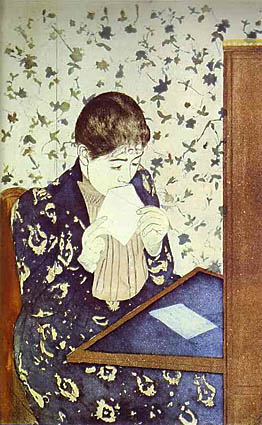 During the 1820s and 1830s, William Talbot in England and Nicéphore Nièpcein France separately (and secretly) labored to focus sunlight through a lens, get the rightexposure (often several hours on cloudy days), transfer the latent image to a plate, etch the plate in various tones, and make a permanent print from the etched plate. Talbot andNièpce each independently succeeded in combining theirexperiments in optics and light-sensitive materials withknowledge of etching and aquatint to create the first gravureprints during the 1830s. Talbot’s Open Door (left) was one of his first successes. He later published a book called The Pencil of Nature which manifested his notion of the new art as ‘sun pictures’ executed by Nature itself in etching ink on paper. Their technique, with a halogen lamp instead of sunlight, is the one I use to make the photogravure etchings shown at this site.
During the 1820s and 1830s, William Talbot in England and Nicéphore Nièpcein France separately (and secretly) labored to focus sunlight through a lens, get the rightexposure (often several hours on cloudy days), transfer the latent image to a plate, etch the plate in various tones, and make a permanent print from the etched plate. Talbot andNièpce each independently succeeded in combining theirexperiments in optics and light-sensitive materials withknowledge of etching and aquatint to create the first gravureprints during the 1830s. Talbot’s Open Door (left) was one of his first successes. He later published a book called The Pencil of Nature which manifested his notion of the new art as ‘sun pictures’ executed by Nature itself in etching ink on paper. Their technique, with a halogen lamp instead of sunlight, is the one I use to make the photogravure etchings shown at this site.
Although painters had used optical devices for several centuries before the invention of photography, camera-made pictures exploded on the art world with reverberations that continue to this day. The invention of photography immediately inverted centuries of European graphic arts tradition, which taught that composition must proceed from broad designs and balance to the filling-in of detail. Suddenly, photography’s seemingly magical fidelity to nature in all its chaotic detail acquired a greater cachet than the studied efforts of academicians to produce a pleasing harmony of color and form. So the new graphic arts technique was denounced by academicians for elevating detail above composition. There ensued an elaborate pas de deux in which photographers imitated drawing and painting, while etchers and painters strove to get beyond realistic reproduction. In this way photography pushed the traditional graphic arts into the 20th century. 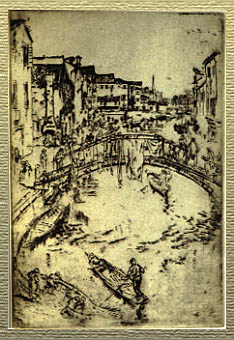 Impressionism was the first style to take advantage of this new freedom from the obligation to simulate reality. Venturing beyond literal reality, Whistler’s ‘Venice Series’ re-drew the relation of the graphic arts to the natural world. Experiments by others followed: distorted and multiple perspectives, expressions of emotional states, Surreal fantasies, until by mid-20th-century, artists had renounced representation altogether. Abstract energy flows, color fields, form, gesture, and the action of art-making itself animated Western abstraction. Unlike Chinese abstraction of nearly a millennium earlier, the Western version responded to the competitive challenge of photography by seeking an alternate reality not accessible to the camera eye.
Impressionism was the first style to take advantage of this new freedom from the obligation to simulate reality. Venturing beyond literal reality, Whistler’s ‘Venice Series’ re-drew the relation of the graphic arts to the natural world. Experiments by others followed: distorted and multiple perspectives, expressions of emotional states, Surreal fantasies, until by mid-20th-century, artists had renounced representation altogether. Abstract energy flows, color fields, form, gesture, and the action of art-making itself animated Western abstraction. Unlike Chinese abstraction of nearly a millennium earlier, the Western version responded to the competitive challenge of photography by seeking an alternate reality not accessible to the camera eye.
Nineteenth-century photographs were made with a variety of techniques, some like photogravure drawn from etching, others resembling watercolor or drawing. Having been ejected from the official Pantheon of Art, however, photography reverted to what the other graphic arts could not do — depict precise detail and ‘capture’ momentary events. Reportage and fashion came to define the new medium, especially after the invention of the 35-mm camera. This eyewitness persona of photography spread to the other graphic arts during the 1960s, as mass-media images became the dominant reference of collective experience. Celebrities were packaged as Art, packaging itself was re-packaged as Art, exalting the most superficial understanding and converging with its own origins in advertising. In Day-Glo colors, blurred graininess, blown-up dots, the visual language of eyewitness photography permeated the art world wherever a claim to verisimilitude was sought. Photography returned to the contemporary art world with a vengeance, annihilating the distinction between fine art and mass media, reducing both to a visual vocabulary of shock. Proliferation of this hackneyed imagery spawned a counter-trend of ‘vintage’ antiquarianism celebrating old, often barely discernible images merely for their age. The bipolar extremes of mass-media imagery and antiquarianism continue to define the photography market, which, in its most expensive regions, remains trapped in the debates that accompanied its origin.
Chinese Abstraction
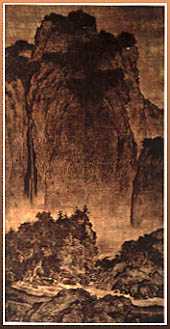 Nearly a millennium before any Western artist used abstraction, Artists of Sung Dynasty China (10th – 13th centuries) discovered and practiced it. Before then, the painters’ job was to memorialize Emperors and the events of their reigns, to produce souvenirs much as tourists do nowadays. The Sung Dynasty was a time of political turbulence, however, with loyalty to one regime repaid by disgrace with its successor. The thoughts of artists and philosophers turned elsewhere in search of something more lasting than political power. Representation gave way to appreciation of the forms of ink on paper or silk, the organization of space, the style of brush-strokes, and of nature itself.
Nearly a millennium before any Western artist used abstraction, Artists of Sung Dynasty China (10th – 13th centuries) discovered and practiced it. Before then, the painters’ job was to memorialize Emperors and the events of their reigns, to produce souvenirs much as tourists do nowadays. The Sung Dynasty was a time of political turbulence, however, with loyalty to one regime repaid by disgrace with its successor. The thoughts of artists and philosophers turned elsewhere in search of something more lasting than political power. Representation gave way to appreciation of the forms of ink on paper or silk, the organization of space, the style of brush-strokes, and of nature itself.
Fan K’uan and his successors used the tonalities of ink to give apparently empty space a tangible presence, making it an object like a rock or tree. These objects do not occur ‘in’ space or time, they are what space and time happen to be doing right now and right here. The notion of ‘capturing’ this instant or this place was, the Sung artists realized, merely a delusion of the memorialists and their Imperial patrons. Their art evoked the ephemeral nature of space and time as these are experienced. Travelers wandering through towering unscalable mountains, fishermen in vast uncharted waters, scholars lost in thought, these favorite subjects of Chinese and Japanese art, are intentionally inconspicuous elements of the vast landscape. In it, a gnarled pine, a rock, the distant mist, even a grain of sand has a significance equal to that of these travelers. From this powerful vision a whole world is animated, with the self merging into its surroundings, the elements of nature inseparable from the tonalities of the artwork.
Materials Matter
Image-forming materials are never neutral recorders. Ink on paper has a certain take on the world, pixels on a screen have a vastly different take. Inthe 16th century, the engraved line was accepted as realistic; a hundred years later it was seen as mannered and artificial, and the more freely-flowing etched line took hold. Painting moved off the frescoed walls and onto more portable canvas just when oil paints provided the means to render chiaroscuro lighting effects convincingly. Watercolor,and then aquatint, became equally adept at portraying fleeting atmospheric and lighting effects. Each medium and style presents a different view and actually changes the way we see.
To make sense of an image, an elaborate mental process takes in information about brightness,color, pattern, and motion, and reconstructs it as something we recognize (or not). It all happens in an instant. Memory, a composite of genetic, cultural, and individual neural pathways,gives the scene familiarity or strangeness: It’s all virtual reality. The visual conventions of the day edit out most of what’s ‘out there,’ assembling the chaos of photons into what the mind accepts as realistic. This lets us get through the day without being detained by questions about what’s real or not, but the conventions of the day eventually seem old-fashioned or deficient in some newly-appreciated aspect of reality. At that point, it falls to art to replace these conventions with new materials and ways of using them.
In ink on paper there is relief from the flat sameness of glossy magazines and from the eye-popping video games in movies, television, and the Web. Photogravure combines the spontaneity of photography with the texture and depth and variety of tonal nuance of etching. The materials are far more than the passive means of making an image visible, they are the living artwork itself. Through them an alternative world is realized, to be explored in depth, again and again, each time with new discoveries. Close-up, the journey of the eye over the surface of the etching reveals varieties of texture, depth, and tone that occur only in intaglio. From a greater distance, different angles of view open up further dimensions of the image.
In photogravure etching, one loses all sense of time and of self, absorbed in a kind of slow-motion ecstasy. The materials of gravure — ink, paper, copperplate, etching resist, ultraviolet light — are simple, yet unforgiving of the slightest error. But the workshop experience brings new visions to the world, and vice versa, in constant interplay. The world is full of infinite visual possibilities unveiled by etching.
![]()
Further Reading
This list was first compiled back in the day when luxuriously designed and printed art books were published, and people read them. Many of these can probably still be found used, though they have become expensive. We’ll keep the list here for those who would like to search for them.
- James Cahill, Chinese Painting (Skira/Rizzoli, 1977).
- Kenneth Clark, Landscape Into Art (Harper & Row, 1984).
- Michael Cooper, Exploring Kamakura (Weatherhill, 1990).
- David Hockney, Secret Knowledge: Rediscovering the Lost Techniques of the Old Masters (Viking Press, 2001).
- Shin·ichi Hisamatsu, Zen and the Fine Arts (Kodansha).
- George Johnson, In the Palaces of Memory (HarperCollins, London, 1992).
- Eastman Kodak Company, Photography With Large-Format Cameras (Eastman Kodak Company,1988).
- KayLarson, Vermeer’s Art of Light. Atelier May/June1996.
- Bernard Leach, The Unknown Craftsman.
- Linhof Prazisions-Kamera-Werke GMBH, Camera Movements (Grossbild-Technik GMBH, Munich, 1973).
- Joseph McDermott, Chinese Lenses and Chinese Art, Kaikodo Journal XIX, Spring 2001.
- Hugo Munsterberg, Zen and Oriental Art (Tuttle, 1993).
- Joseph Pennell, Etchers and Etching (Macmillan, 1929)
- Richard Rand and John Varriano, Two Views of Italy: MasterPrints of Canaletto and Piranesi (Hood Museum,Dartmouth College, 1995).
- George Sansom, The Western World and Japan (Vintage, 1973)
- Larry Schaaf, Out of the Shadows (Yale University Press,1992).
- Daisetz Suzuki, Zen and Japanese Culture (Tuttle, 1994)
- Jeffrey Wechsler, Asian Traditions / Modern Expressions (Abrams & Zimmerli Museum, 1997).
- Lawrence Wechsler, ‘The Looking Glass’, The New Yorker, January 31, 2000.
- Soetsu Yanagi, Kogei no Michi (The Way of Crafts) (1927).
Photogravure etchings are made from an aquatinted copperplate etched to various depths through a permeable resist, the resist having previously been exposed through a transparency with ultraviolet light, then adhered to the copperplate.
![]()